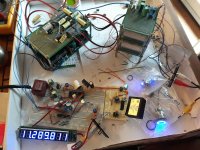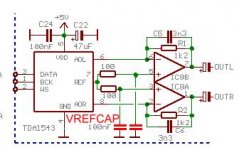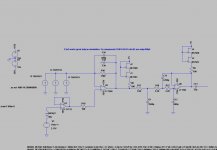Hello, I've implemented on breadboard the following TDA1543 (3 in parallel) circuit with very good sonic results, but I have hi-speed opamp oscillating (even if unity gain stable).
No Vref resistor to ground was needed.
I suspect to have too long wires (> 15 cm) between TDA1543 outputs and IV opamp.
The oscillation stops if I put a vref capacitor of 10nF (min) between V+ (Vref) and ground.
I tried also 100nF, 1uF, 100uF, which work ok but the sound is more "airy" between 10nF and 100nF
If I put less vref cap (<10nF), hi slew rate opamps start to oscillate (the slow ones still work ok, even without cap).
I don't see similar "vref-to ground" cap in any IV active schematic, so I'm asking to you any comment on this issue and benefit to have it.
Thanks
No Vref resistor to ground was needed.
I suspect to have too long wires (> 15 cm) between TDA1543 outputs and IV opamp.
The oscillation stops if I put a vref capacitor of 10nF (min) between V+ (Vref) and ground.
I tried also 100nF, 1uF, 100uF, which work ok but the sound is more "airy" between 10nF and 100nF
If I put less vref cap (<10nF), hi slew rate opamps start to oscillate (the slow ones still work ok, even without cap).
I don't see similar "vref-to ground" cap in any IV active schematic, so I'm asking to you any comment on this issue and benefit to have it.
Thanks
Attachments
Last edited:
The 'airy' sound is probably from it ringing or oscillating intermittently, not a reliable state of affairs for a final circuit. Adding caps to Vref basically acts as a low pass filter, not necessarily a bad thing for Vref. If you need to use caps there probably they should be big enough to fully stop all oscillation and any related symptoms.
Thanks for the reply. "Adding caps to Vref basically acts as a low pass filter" I immagine not for the audio signal, but to clean from RF Power supply. Correct?
Even if, no way, I continue to prefer the 10 nF cap over 100nF and more...
On simulation nothing changes by changing VREF cap.
Unfortunately datasheet doesn't say too much for Vref and the only circuit I see with Vref capacitor to ground over internet is applied to TDA1545 page 4 and never on TDA1543.
It is a pity for me not to understand this RF issue as measurements (with 100nF) and listening tests are very satisfying to me even with this messy layout and very poor power supply. see graph.
(FYI I never had a unity gain LTC opamp oscillating like a Radio...This is first time. Strange that LME49860 doesn't oscillate...)
Even if, no way, I continue to prefer the 10 nF cap over 100nF and more...
On simulation nothing changes by changing VREF cap.
Unfortunately datasheet doesn't say too much for Vref and the only circuit I see with Vref capacitor to ground over internet is applied to TDA1545 page 4 and never on TDA1543.
It is a pity for me not to understand this RF issue as measurements (with 100nF) and listening tests are very satisfying to me even with this messy layout and very poor power supply. see graph.
(FYI I never had a unity gain LTC opamp oscillating like a Radio...This is first time. Strange that LME49860 doesn't oscillate...)
Attachments
-
tda1543C.asc5.6 KB · Views: 26
-
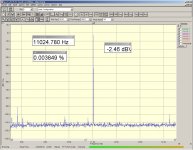 tda 3x jtest poor supply 680pf + 100n.jpg338.9 KB · Views: 190
tda 3x jtest poor supply 680pf + 100n.jpg338.9 KB · Views: 190 -
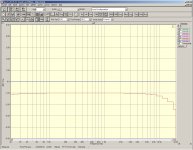 tda 3x freq poor supply 680pf + 100n.jpg296.6 KB · Views: 177
tda 3x freq poor supply 680pf + 100n.jpg296.6 KB · Views: 177 -
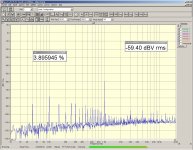 tda 3x THD -60 poor supply 680pf + 100n.jpg408.2 KB · Views: 159
tda 3x THD -60 poor supply 680pf + 100n.jpg408.2 KB · Views: 159 -
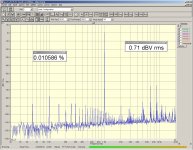 tda 3x THD poor supply 680pf + 100n.jpg419 KB · Views: 43
tda 3x THD poor supply 680pf + 100n.jpg419 KB · Views: 43 -
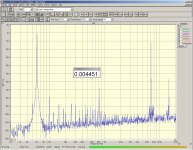 tda 3x IMD poor supply 680pf + 100n.jpg410.3 KB · Views: 54
tda 3x IMD poor supply 680pf + 100n.jpg410.3 KB · Views: 54
Please learn how to design PCB's and/or single board designs and avoid such wiring. It saves time and gives better results.
You are right but before soldering a PCB or a good perfboard, I need to try and test which is the "best" sounding circuitry.
I know but it is debatable if one can discern differences in a setup like that. After having redesigned a PCB tens of times your approach clearly also has its merits
Which is your opinion regarding Vref Capacitor on TDA1543?
I would include even if the final layout will eventually stop oscillations.
Although I made a few DACs with TDA1543 I now think it is too low in specs for real good sound quality. It is easily surpassed by modern chips that sound better and are cheaper to implement. This is why I practically erased all info on TDA1543 from my memory. I noticed I do have a rail of them in stock (just like its slightly better brother TDA1545).
why not add another buffer on the Vref pin? Use ultra low noise type.
Thanks for this input. I tested with LT1113 very close to LT1358 (like in the attached scheme) and ...it works! No more oscillation even with an even more additional "shitty" wiring.....
But that sounds a little dull... It is ok, but lost emotion...
I would stay with 100nF from Vref to ground, more open and live, even if I'm pretty sure that with the final clean layout oscillations will stop.
I suspect that with 10nF I have too low margin.
Thus I would close mine TDA1543 test.
By using Russian PIO and TEFLON output capacitors + LT1358&AD826 IV output filter and class A buffer + 3 TDA1543 in parallel + CS8412 + AD8611 4ns comparator at SPDIF RCA coax input, I can vote the sound 8/10. That would be nearly definitive (it already beats to my ears ONKYO NS-6103 internal DAC and NAD CD525BEE player) but now I want to test:
PCM56
CS4303
PCM1710
and see if they can beat this triple TDA1543 parallel configuration.
Plus I'm going to test:
1) low jitter asyncr slave CS8412 reclock with JFET 310 and AD8611 4ns comparator
2) such reclock but PLL locked with 74AS logics to the network player clock.
J-Test jitter test is already good (see previuos measurement), but I'm expecting to improve it. Very curious to test.
The above are not mine 100% designs but they are a mix of the best schematics I found over internet with just few modifications on my side.
If you like I can continue in this thread the above tests.
I would suggest you to buy for less than 10USD from China the frequency counter I'm using (see prevouis photo): it is amazing connected to the CS8412 and works great to show you the current DAC clock frequency.
That will help me to test PLL internal clock I'm going to build (if it works...)
Attachments
Last edited:
I would stay with 100nF from Vref to ground, more open and live, even if I'm pretty sure that with the final clean layout oscillations will stop.
The breadboard is not suitable for DAC. Even those universal test board are not recommended either. I use test board for I/V & buffer. I got weird THD+N as the result.
Poting
PCM56
CS4303
PCM1710
CS8412
..
why do you want to test all the outdated parts? There are many cheaper & better parts available:
DAC:
PCM5102 / PCM5122
ES9018K2M
SPDIF Receiver:
DIR9001
AK4117
I'd recommend that at least you should use one of the modern SPDIF Receivers, you can get ready made boards from ebay or Aliexpress under €20...
Don't fear the SMD packages, either you can use adapters to DIP or like I suggested use those china-boards.
CS4303
PCM1710
CS8412
..
why do you want to test all the outdated parts? There are many cheaper & better parts available:
DAC:
PCM5102 / PCM5122
ES9018K2M
SPDIF Receiver:
DIR9001
AK4117
I'd recommend that at least you should use one of the modern SPDIF Receivers, you can get ready made boards from ebay or Aliexpress under €20...
Don't fear the SMD packages, either you can use adapters to DIP or like I suggested use those china-boards.
But that sounds a little dull... It is ok, but lost emotion...
That is often the first impression once the circuit stops oscillating.
Jan
PCM56
CS4303
PCM1710
CS8412
..
why do you want to test all the outdated parts? There are many cheaper & better parts available:
DAC:
PCM5102 / PCM5122
ES9018K2M
SPDIF Receiver:
DIR9001
AK4117
I'd recommend that at least you should use one of the modern SPDIF Receivers, you can get ready made boards from ebay or Aliexpress under €20...
Don't fear the SMD packages, either you can use adapters to DIP or like I suggested use those china-boards.
Hello here following reasons of such decisions, as I want/like:
0) build from scratch a DAC by myself, totally 100% homemade
1) test and select the "best sounding" among at least four DACs, two NOS and two Delta-Sigma, to compare. I know very well the sound of PCM1710 in my NAD CD player, thus this and the internal DAC of the Onkyo network player will be the reference points in this test.
Some peculiarity: PCM56 have MSB adjustment and someone said that PCM56 is better sounding dac in NONOS even compared to TDA1541; CS4303 is a Return-to Zero (RZ) DAC, quite exclusive; TDA1543 is extremely simple and still competitive as sounding quality (I tested!). They all must also easy to be found under ebay etc...
2) No need of super high resolution: just run 44Hz/16bit coax 75 ohm output, get rid of CD player and move to FLAC/WAV gapless liquid music. For this I got Onkyo NS6130 network player as a source.
3) Opamp IV filter with (mandatory!) AD826 class A buffer, plus LT1358 or LME49860 in the analogue stage. Hence, exclude internal DAC OPAMP: TDA1543 PCM56 and CS4303 permit to use "exclusively" my fast opamp configuration.
4) exhaustive internet documentation, schematics, MODs, forum discussions, CDPlayers service manuals and people who have successful tested these, possibly showing internal asyncr reclock or syncr PLL. I think to have collected more that 350 different schematics for CS8412 and the four mentioned DACS.
5) the protocol flexibility of CS8412 (I2S, Master/Slave, LSBJ etc etc)
6) work in dip as much as possible
7) possibility to reclock with 74AS logics (4ns in DIP!) and synchronous 8-bit counter SN74AS869. Build even a syncr reclock with PLL. All the four DAC can work with the same 11.2896MHz crystal reclocking low-jitter module I'm going to build.
Next to test is PCM56: yesterday I lost all the afternoon because they didn't work (only RF noise!).
I was giving up when I realized today that the protocol is not I2S like TDA1543, but I had to change CS8412 into Mode 5, "16 Bits LSBJ" !!!

I'm going to post photo, results and scheme next days.
Will use six PCM56 chips, three in parallel per channel to have enough current for my analogue opamp IV converter module.
- Status
- This old topic is closed. If you want to reopen this topic, contact a moderator using the "Report Post" button.
- Home
- Source & Line
- Digital Line Level
- TDA1543 and IV opamp oscillating
